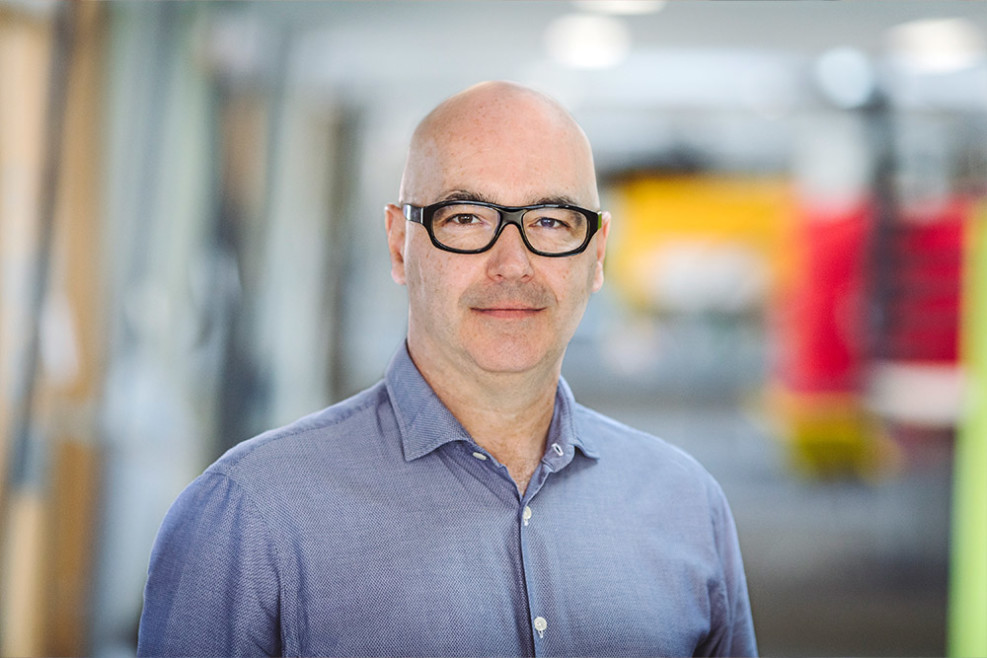![]()
The idea of Artificial Intelligence has been providing creative artists with material for their stories and designs for the future since the 18th century. The mostly gloomy dystopias flank the technical developments of the time and thus reflect the human-machine relationship with regard to ethical and media-scientific questions. In the meantime, however, we have arrived at a time when what was once an idea and fantasy is now a reality. This is also the case with Artificial Intelligence (AI), which has become a buzzword in the media and tech industries. Even creativity is no longer safe from it, at least that’s what many people claim. We spoke to Eugen Gross, founder of the company aiconix and himself fascinated by AI technology. He sees AI as a tool that we must learn to use. Coming from the creative industry himself, he has precisely this in mind with his vision.
Eugen Gross was born and raised in Austria. After school, he worked as a camera assistant at a film production company in Vienna, back then still with celluloid and the big dream of going to Hollywood. In the 1990s, the golden years of German television, the young creative moved to Berlin. There was enough demand for personnel, but at that time it was not at all easy for a foreigner like Eugen to get a work permit. So he went into business for himself as a cameraman and got around the problem. In the course of time, he has filmed everything there is to do with music, entertainment and shows in this country.
Creativity and technology are close to each other and Eugen has always been passionate about both. And so, for a time, he also worked as a satellite technician for live broadcasts. But since he was more fascinated by creative work, he quickly ended up behind the camera again. We asked him in an interview how he became an entrepreneur from there, what his vision for aiconix is and what creativity in the context of Artificial Intelligence means to him.
Eugen, how did you go from working as a creative and media professional to founding aiconix?

Eugen Gross, Founder of aiconix – © Morris Mac Matzen
During my studies (Executive MBA) in media management, I dealt a lot with data. Especially in the creative industries, I saw an imbalance in who has access to certain data in publishing houses, for example. The marketing department, for example, knows that a certain target group has turned off a film at a certain point. But we creatives don’t have access to such data. That means I could make a film x times, but each time I lost a part of the audience at a certain point because I didn’t have that information and couldn’t learn from it. Maybe it was the protagonist, the storytelling or the music. The data would have shown me that. In my master’s thesis, I then dealt with Artificial Intelligence in this context and aiconix came out of that.
What exactly does aiconix offer?
At the beginning, we looked at Artificial Intelligence and what was available on the market: who is good at speech recognition, who is good at facial recognition, who is the best at semantic analysis, etc. We then received a grant and started to work on aiconix. We then got a scholarship and moved to the Technical University of Hamburg, where we did research and collected data. During our work, we quickly realised that there is a great need for a platform that bundles all the existing providers on the market. We then turned such a platform into a start-up. In the meantime, however, we not only bundle the providers, but in the area of speech recognition we go much deeper. We have several speech models running in our own infrastructure and can always combine and evaluate which model delivers the most accurate result. In this way, we can always be better in speech recognition than the individual providers.
What are the areas of application for your product?

The target group are companies that own media content. And today there are hardly any that don’t do that. And here, accessibility is the biggest issue at the moment. Because every company should enable barrier-free access. Our product can subtitle and translate press conferences in real time, for example. The demand for this is enormous. In the future, television broadcasters will also have to become increasingly accessible. They may have large subtitling departments, but they can’t possibly handle the mass of content. And that’s where AI is a useful tool that can’t solve everything, but which can generate metadata for large amounts of data very quickly. This makes connections visible and understandable.
To what extent is this also interesting for creative professionals?
When we used to shoot a feature, we were allowed to use four minutes of celluloid for one minute of broadcast. Today that’s ridiculous, you have a mobile phone, a GoPro, a second camera, a counter shot… hundreds of hours of content are created quickly. And as a creative person, you can’t concentrate on the creative process if you’re basically busy with mechanical work. This is also true for journalists who are so busy transcribing that they don’t get to write their articles in peace, which is what they love. For that, you need tools that support you, and AI can be such a tool.
“An AI is only as smart as the data you add to it.”
The term Artificial Intelligence covers all sorts of techniques and applications, such as algorithms, neural networks, machine learning etc. Can you briefly explain how you use the term?
I’m not a developer either. But my partner at the time always said that an algorithm is only as clever as the developer behind it. And an AI is only as clever as the data you’ve added. For example, if we make a language model with data from northern Germany, the result will be completely different than if the data comes from Bavaria. That is why, strictly speaking, this is not AI, but machine learning. Here, the machine is taught something. You give it a million pictures of cats and a million pictures of dogs and in the end the machine will not be able to do anything other than distinguish dogs from cats. People like to claim that AIs have long been able to be creative because, for example, they write music when you give them music data. For me, however, that is not creative, but a repetition of what the AI has learned and plays out again in a modified form. For me, creative means breaking with rules and norms when something really new emerges, where decisions are made for or against something. Creatives have always dealt with new technology that has changed their work and ultimately the content. And I think AI is also a new tool that creatives have to learn to use. Many of my colleagues are still very afraid of it.
Do you have a vision for aiconix on how such an AI tool could be applied in the creative industry?

I have a vision, yes. The platform we are marketing now is just the basis for it. The idea is to have an AI that supports me in evaluating the many data of the viewers, so that I can see what a certain target group likes and what not. It’s about recognising what’s happening in the video and how that relates to user behaviour in different target groups. But we didn’t just want to know when a person decides to switch off, we wanted to know when we lost them dramaturgically. To do this, we had test persons watch videos at the university and collected professional EEG data in the neurolab. This allowed us to see when attention had waned. With this data, an AI can give the creators an indication of where something is happening dramaturgically with the users and which parts they should watch again. I would like to bring together these two worlds, creativity and data, and see what comes out when you let the data advise you without letting the creativity be taken out of your hands. Bringing that together is really high end, but that’s exactly my vision for aiconix. I just want to tell good stories.
There is a broad social debate about the problem of algorithms and how they influence our realities. It’s not just about playlists on Spotify and the danger of one-size-fits-all, but also about influencing political elections. There is a lot of scepticism and also fear towards such technologies. Can you understand that?
Definitely! But that’s exactly the point: we first have to learn how to deal with the technology. You don’t have to dive deep into it. But it is important to understand what it can and cannot do. And when we have understood that, then we also have the possibility to question the result. Maybe in the future we will also have to publicly display when an AI has produced content. Finland is a good example of this, where the population can be trained in AI use in free courses. This is a good way to understand what the technology can do, what its limitations are and that it can also be used for things that are not good. I hope that creative people in this country will look at it in the same way and then decide whether they want to use it or not. AI is a technical extension. Classical art, music or painting will not disappear just because there are additional AI creations. AI is not science fiction, it is the Swiss army knife that we all hope to have in our pockets soon so that we can work faster and be supported in creative processes.






Leave a Reply